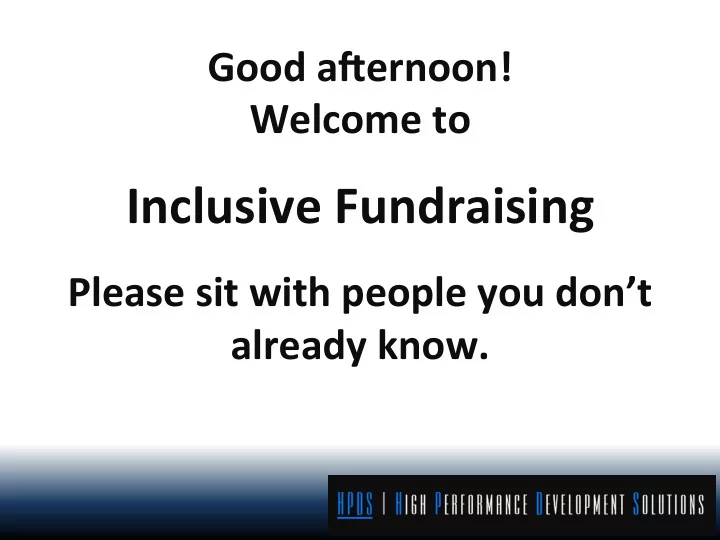

Good a&ernoon! Welcome to Inclusive Fundraising Please sit with people you don’t already know.
I NCLUSIVE F UNDRAISING D EBORAH A. B IDDLE Madison Non Profit Day Conference October 13, 2016
INCLUSIVE FUNDRAISING Today we’ll: • Examine the need for inclusive fundraising • Explore the significance of inten7onality, relevance and asking • Look at donor habits of African-American, Asian and La7no donor communi7es • Brainstorm ideas to increase donor par7cipa7on among diverse people groups.
Discussion InstrucXons When when you hear me ring the triangle, finish your sentence and raise your hand. Be prepared to share your best idea or discovery.
I NTRODUCTIONS You have three minutes in total (90 seconds each). Turn to the person next to you. State your name and the organiza7on you represent and the following ques7on …. “How does your organizaXon do it’s funding among communiXes of color?”
W HY S HOULD F UNDRAISING B E M ORE I NCLUSIVE ?
PopulaXons of people of color are growing. In 1967, 78% of Americans were classified as White. By 2006, just over 60% of Americans were classified as White
W HY S HOULD F UNDRAISING B E M ORE I NCLUSIVE ? • Popula7ons of people of color are growing. • Na7onally, 60% of non-profits serve people of color. • People of color want to give.
Two things I’ve learned: • Be Inten7onal • Be Relevant
R u t h P a u l C a u d l e
Ruth Paul Caudle in HaiX with children from the Spirit of Truth School
Spirit of Truth School in Kenscoff, HaiX
Why did I say, “Yes,” to Ruth?
I NTENTIONAL Deliberate – Well thought out • Persuasive – Sincere and passionate • Specific – Clear about the request amount and • expected commitment Simple – Easy for donors to give • Transparent – Results and financials readily available • LegiXmate – Nearly all of my dona7on goes directly • to the cause
R ELEVANT Connected – Know something about prospec7ve donors; do the • research Credible – Are you culturally competent to reach the group you seek • to engage? What will it take to become competent? Significant – Be clear about why poten7al donors should care about • your fundraising efforts. Interested – Ask prospec7ve donors, “What’s the most important • thing to you about _____________ ? People want to be invested in your cause — not just financially, but emo7onally. Inclusive - Ask for donor input, “Can I pick your brain on a problem • I’m trying to solve?”
T ABLE E XERCISE What about you? What compels you to give when asked? Take 3 minutes to discuss with those at your table the factors that most incline you to give when asked.
How do giving prioriXes, habits and aftudes affecXve donor communiXes of color?
African American Donor Community Religion and faith are a more important part of philanthropy than among any other group Not as likely to give through direct response channels, but also not being asked More than any other group, interested in suppor7ng their unique heritage and community Giving is more personal and spontaneous; youth development groups are of par7cular interest February 2015 blackbaud, Diversity in Giving: The Changing Landscape of American Philanthropy
Asian Donor Community Generous U.S. donors, even though this group is more likely to have been born outside the U.S. Younger, well educated, more likely liberal and female Most technologically connected and willing to use alterna7ve giving channels Giving priori7es are different – more likely to support emergency relief efforts and educa7on; religion not as important as a driver of philanthropy More likely to plan and research their philanthropy February 2015 blackbaud, Diversity in Giving: The Changing Landscape of American Philanthropy
LaXno Donor Community Youngest of all groups and most likely to have children in their households Strong commitment to children’s causes Much more likely to say they give spontaneously, when something pulls at their heart strings Give larger percentage of income to church than donors overall Not asked for dona7ons as frequently as others, and not as likely to give through tradi7onal direct response channels; most interested in hearing more from nonprofits February 2015 blackbaud, Diversity in Giving: The Changing Landscape of American Philanthropy
T ABLE E XERCISE For 7 minutes, brainstorm ideas you can implement to beeer target your marke7ng and fundraising efforts to increase donor par7cipa7on among diverse people groups. Be prepared to share your best idea.
ReflecXon Exercise In what ways might your typical fundraising methods and channels exclude some racial and ethnic groups?
What’s next?
Create inclusive fundraisers.
Develop long-term strategies to engage mulXcultural long-term donors.
Transform the face of the philanthropy profession.
Revaluate your mission and funding pracXces.
Avoid presumpXon.
Comments or QuesXons?
Contact InformaXon Deborah A. Biddle High Performance Development SoluXons Mobile: (608) 239-6184 Email: debbiddle@hp-development.com Web: www.hp-development.com
Recommend
More recommend